Who Controls the User Experience? AMD’s Carrizo Thoroughly Tested
by Ian Cutress on February 4, 2016 8:00 AM ESTGaming Benchmarks: 3DMark and Rocket League
Due to timing we were only able to run a couple of gaming tests, namely parts of the 3DMark suite and our Rocket League test. A reminder of our systems, including their graphics:
| System Overview | ||||
| µArch | APU + GPU | Memory | Channel | |
| HP Elitebook 745 G2 | Kaveri | A10 PRO-7350B (19W) R6, 384 SPs, 533 MHz |
8 GB | Dual |
| HP Elitebook 745 G3 | Carrizo | PRO A12-8800B (15W) R7, 512 SPs, 800 MHz |
4 GB | Single |
| Toshiba Satellite E45DW-C4210 |
Carrizo | FX-8800P (15W) R7, 512 SPs, 800 MHz |
8 GB | Single |
| HP Pavilion 17z-g100 |
Carrizo | A10-8700P (15W) R6, 384 SPs, 800 MHz |
8 GB | Single |
| Lenovo Y700 | Carrizo | FX-8800P (15W) R7, 512 SPs, 800 MHz R9 385MX, 512 SPs, 900-100 MHz |
16 GB | Single |
One of the biggest issues we’ll see here is the effect of dual channel memory on gaming. The Kaveri system used has a chipset solution that supports dual graphics, but also two memory modules installed. The Carrizo systems either came pre-prepared with one module installed or do not support dual channel memory full stop. This latter point is the main kick in the teeth, especially for a company like AMD that prides itself on gaming – the issue here is down to pin compatibility between Carrizo and Carrizo-L. As the latter only supports single channel, an OEM will design one motherboard to support both platforms (whether they are used for both or not). If a motherboard supports Carrizo-L, then it will not ever support dual channel memory, and any Carrizo APU that is used will be crippled.
Technically the Lenovo Y700 gets around this (hands up if you ever see a Carrizo-L based Y700 please) by equipping the system with a discrete graphics card and disabling Crossfire, so this system will still ultimately win in our tests due to the discrete card. The downside of this augmentation is the higher power draw, which would matter if our Y700 sample had a battery (the retail units come with a 60 Wh battery).
3DMark
3DMark is Futuremark's premium software, developed to tax systems at various different performance levels. The software contains several benchmarks as a result, with some focusing more on smartphone use all the way up to 4K, quad-SLI systems with as many in-game and post processing effects as you can throw at it. The base test, Ice Storm, is actually a good indicator of GPU scaling performance, but we also test Cloud Gate, Sky Diver and Fire Strike to get a measure of all of our systems.
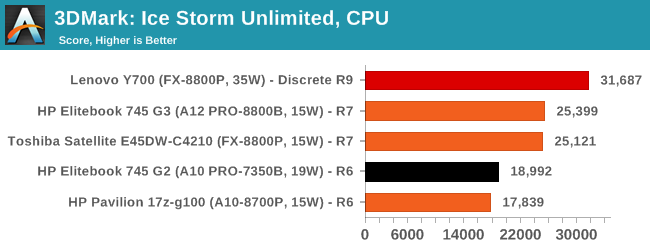
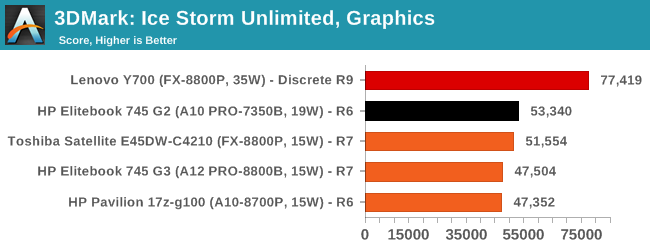
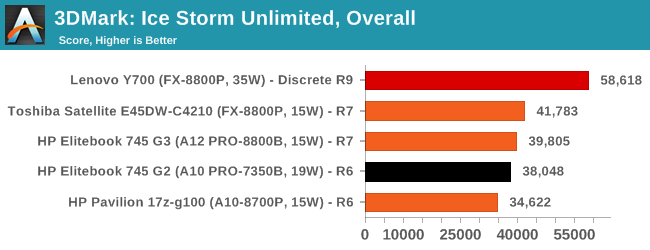
The easiest test, Ice Storm, shows the performance benefits of the Carrizo APUs in the CPU stage, although the dual channel memory for the Kaveri kicks in and gives it the graphics lead. The overall scores however benefit from that high CPU boost, so Carrizo at 15W on single channel wins this round.

Moving up in difficulty to Cloud Gate puts dual channel Kaveri in the lead, although the Toshiba is holding on a bit with its higher thermal skin temperature limit.
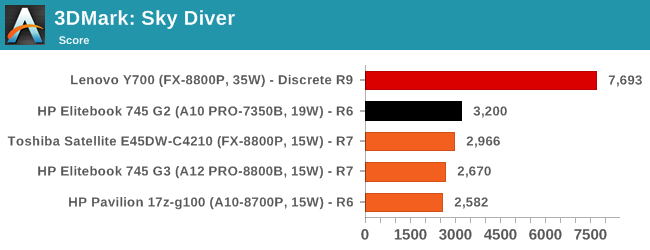
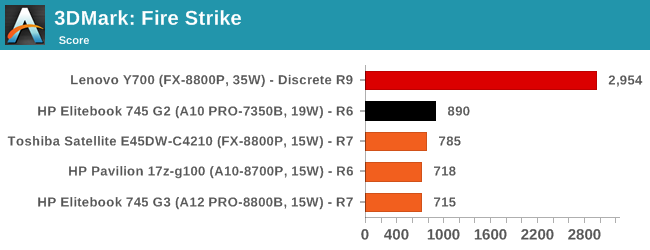
The last two benchmarks fall square with the dual channel configuration. The GDDR5 of the discrete graphics card in the Y700 wins out on all of them.
Rocket League
Hilariously simple pick-up-and-play games are great fun. I'm a massive fan of the Katamari franchise for that reason — passing start on a controller and rolling around, picking up things to get bigger, is extremely simple. Until we get a PC version of Katamari that I can benchmark, we'll focus on Rocket League. Rocket League combines the elements of pick-up-and-play, allowing users to jump into a game with other people (or bots) to play football with cars with zero rules. The title is built on Unreal Engine 3 and it allows users to run the game on super-low-end systems while still taxing the big ones. Since the release earlier in 2015, it has sold over 5 million copies and seems to be a fixture at LANs and game shows.
With Rocket League, there is no benchmark mode, so we have to perform a series of automated actions. We take the following approach: Using Fraps to record the time taken to show each frame (and the overall frame rates), we use an automation tool to set up a consistent 4v4 bot match on easy, with the system applying a series of inputs throughout the run, such as switching camera angles and driving around. It turns out that this method is nicely indicative of a real bot match, driving up walls, boosting and even putting in the odd assist, save and/or goal, as weird as that sounds for an automated set of commands. To maintain consistency, the commands we apply are not random but time-fixed, and we also keep the map the same (Denham Park) and the car customization constant. We start recording just after a match starts, and record for 4 minutes of game time, with average frame rates, 99th percentile and frame times all provided. For these tests, we used the 1280x720 resolution at high settings. A bigger explanation of testing can be seen in our AMD A8-7670K APU review.

Built on UE3 and DX9, the game relies heavily on single threaded performance and at this level of detail, memory bandwidth. The Kaveri takes the crown, showing that at this level adding another stick of memory (and making sure you have the right configuration) is more important than a more advanced (or perhaps expensive) APU.
We’ll go into temperatures on the next page.















175 Comments
View All Comments
Kylinblue - Friday, February 5, 2016 - link
When I saw the sub-page title "AMD's Industry Problem" I though it is the conclusion, after reading that page I found out I am just at half of the whole article. Well done Ian, well done...ImSpartacus - Friday, February 5, 2016 - link
I know, right? I'm one of those weirdos that reads the pages backwards (mostly), so I was immediately surprised at the list of pages before the conclusion. I honestly haven't finished even half of the article, but it's already evident that some tlc went into it.just4U - Saturday, February 6, 2016 - link
A excellent article Ian.. and actually a surprise I wasn't expecting anything in the pipe like this right now.SviatAI - Friday, February 19, 2016 - link
Unfortunately, this often happens when you work for some ecommerce shop selling various goods, the boss of the shop may not want such kind of articles about the products he or she sells. They want it now and fast, just to fill the site with irrelevant content. The problem is that you want to make something better than a stupid re-write. But who cares? So, I am happy for those guys who write for AnandTech and other similar websites. They can learn something new while doing their job.CajunArson - Friday, February 5, 2016 - link
This article certainly proves one thing: When it comes to price lists on Intel Mobile parts, the numbers you see on ARK have absolutely nothing to do with the actual price that OEMs pay in real life.Observe the supposedly major $200 price premium for Intel chips when you read a price list in a vacuum, but then see that the real-life Intel system [with an honest-to-God *quad core* chip!] is basically selling for the exact same price as a much less capable Chorrizo part.
I personally got a Costco-Special notebook for the wife last year at $500.. it has an I5-5200U, and I assure you that the OEM most certainly didn't sell that notebook at that price after spending $300 on the CPU.
extide - Friday, February 5, 2016 - link
BTW, that's not a quad core. It's dual, with hyperthreading :)CajunArson - Friday, February 5, 2016 - link
When I said quad core I was referring to the Core i5-6300HQ (45W) in the price comparison that Anand posted. It is a 4 physical core part in a notebook that only costs $8 more than a "4 core" Carrizo using AMD's "cores".I am aware that the 5200U is a dual-core hyperthreaded part too. Like I said, the entire price of the notebook including the 5200U was only $500 (it has 8 GB of RAM too).
extide - Tuesday, March 22, 2016 - link
Ah, yes, Intel is FINALLY shipping quad core mobile i5's. Good call :)vladx - Saturday, February 6, 2016 - link
Except you didn't put in consideration that what you bought was called "Special" for a reason and it wasn't the release price of the product that was most likely $200+ more.Braincruser - Friday, February 5, 2016 - link
AMD still has a long way to go before its considered a valid choice. The 4.5W intel beats it in the tasks its gonna be used in. Even in graphics, the supposed strong side of amd's APU.